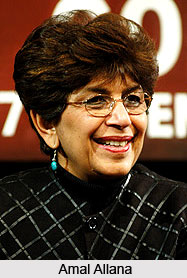 Alam Allana is the director and designer in Hindi theatre. She was born in Bombay. She is the daughter of Ebrahim Alkazi. Alam Allana studied at the National School of Drama (NSD), graduating in 1968 with the best director`s award. She went to Germany to train at the Berliner Ensemble, Weimar National Theatre, Volksbuehne, and the Deutsches Theatre of East Germany. In India, she taught in the Department of Indian Theatre, Punjab University, Chandigarh where she served as head, in the year of 1977-8, and at NSD. Her acclaimed productions include Mannu Bhandari`s Mahabhoj i.e. `Great Feast` in 1982, Aurat bhali Ramkali i.e. `Ramkali the Good Woman` in 1984, from Brecht`s Good Person of Setzuari, Rajajaswant Singh from Shakespeare`s King Lear in 1989, and Himmat mai i.e. Brecht`s Mother Courage in 1993. A visual, artistic approach characterizes her work. She also directs television drama, notably so far versions of Mohan Rakesh`s Adhe-adhure, Satish Alekar`s Begum Barve, Manjula Padmanabhan`s Lights Out, Prashant Dalvi`s Char chaughi i.e. `Four Ordinary Women`, and Brecht`s Threepenny Opera. In films, she designed sets for Richard Attenborough`s Gandhi in 1982 and costumes for Mahesh Bhatt`s Saransh i.e. `Gist` in 1984.
Alam Allana is the director and designer in Hindi theatre. She was born in Bombay. She is the daughter of Ebrahim Alkazi. Alam Allana studied at the National School of Drama (NSD), graduating in 1968 with the best director`s award. She went to Germany to train at the Berliner Ensemble, Weimar National Theatre, Volksbuehne, and the Deutsches Theatre of East Germany. In India, she taught in the Department of Indian Theatre, Punjab University, Chandigarh where she served as head, in the year of 1977-8, and at NSD. Her acclaimed productions include Mannu Bhandari`s Mahabhoj i.e. `Great Feast` in 1982, Aurat bhali Ramkali i.e. `Ramkali the Good Woman` in 1984, from Brecht`s Good Person of Setzuari, Rajajaswant Singh from Shakespeare`s King Lear in 1989, and Himmat mai i.e. Brecht`s Mother Courage in 1993. A visual, artistic approach characterizes her work. She also directs television drama, notably so far versions of Mohan Rakesh`s Adhe-adhure, Satish Alekar`s Begum Barve, Manjula Padmanabhan`s Lights Out, Prashant Dalvi`s Char chaughi i.e. `Four Ordinary Women`, and Brecht`s Threepenny Opera. In films, she designed sets for Richard Attenborough`s Gandhi in 1982 and costumes for Mahesh Bhatt`s Saransh i.e. `Gist` in 1984.
Fellowship or Awards of Amal Allana can be mentioned as below.
Research Fellowship of the Ford Foundation on Indian Theatre in 1990-1992, Girish Ghosh Award for Best Director, Bharat Purushkar for the best all-round student in National School of Drama, Homi Bhabha Fellowship in the year 1975-1977, Scholarship of the German Democratic Republic to study the work of Bertolt Brecht in 1969.




















